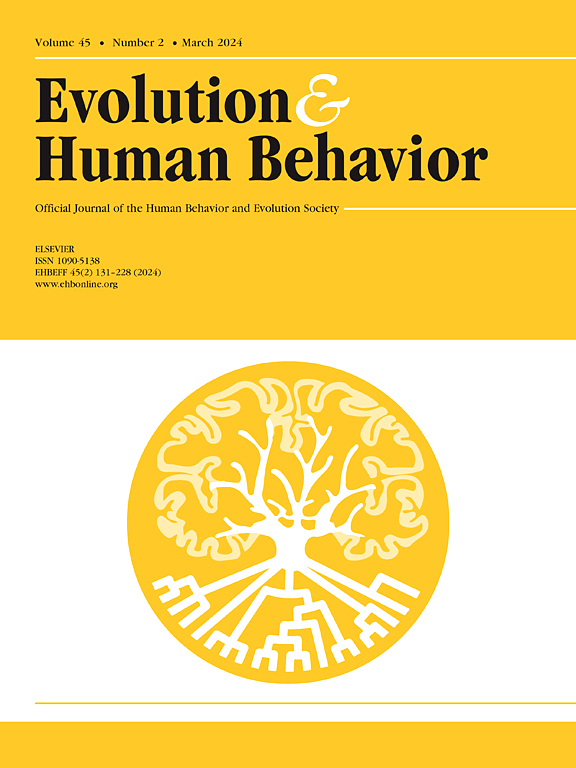资源制度性再分配下公共物品博弈中精神病的演化
IF 3.2
1区 心理学
Q1 BEHAVIORAL SCIENCES
引用次数: 0
摘要
根据Testori等人(2022)的模型,我们研究了公共物品博弈中精神病患者进化的动态,该博弈既包括惩罚精神病患者(自私/操纵的冒险行为者),也包括奖励合作者(慷慨、厌恶风险的行为者)。我们系统地改变了精神病态表型的死亡率,以及它们在丰富或恶劣的环境中对社会造成的社区成本,以检查它们如何影响人口规模和人口中精神病态因子的比例。我们的目的是确定资源再分配的哪种机制组合能够使模型收敛于解决方案,在该解决方案中,精神病患者在人口中的百分比非常低,与对人口的经验估计一致。模型模拟揭示了几个值得注意的结果。首先,出现精神病的低频率:1)如果精神病表型具有高死亡率;2)如果社会不仅惩罚精神病患者,而且积极奖励慷慨的个人。第二,精神病态在稀缺环境和小群体中表现出较高的适应度;后者的结果与现有的关于群体规模与精神病适应潜力之间关系的理论不一致。因此,该模型强调,除了对精神病患者的惩罚之外,对合作个体的社会奖励是维持精神病表型频率在低水平上的关键社会生态条件。本文章由计算机程序翻译,如有差异,请以英文原文为准。
Evolution of psychopathy in the public goods game with institutional redistribution of resources
Following the model of Testori et al. (2022), we examined the dynamics of the evolution of psychopathy in the public goods game that incorporates both punishing psychopaths (selfish/manipulative risk-taking agents) and rewarding cooperators (generous, risk-averse agents). We systematically varied the mortality of psychopathic phenotypes, and the community cost they inflict on society in an abundant or harsh environment in order to check how they affect population size and the proportion of psychopathic agents in the population. Our aim was to determine which combination of mechanisms for the redistribution of resources enables the model to converge to the solution where the percentage of psychopathic individuals in the population is very low, consistent with empirical estimates on human populations. Model simulations revealed several notable results. Firstly, a low frequency of psychopathy emerges: 1) if psychopathic phenotypes have a high mortality rate; and 2) if society not only punishes psychopaths but actively rewards generous individuals. Secondly, psychopathy showed higher fitness in scarce environments and small-sized populations; the latter result is incongruent with existing theories about the association between population size and the adaptive potential of psychopathy. Hence, the proposed model highlights, in addition to punishment of psychopaths, the societal reward for cooperative individuals as the crucial socioecological condition that maintains the frequency of psychopathic phenotypes at a low level.
求助全文
通过发布文献求助,成功后即可免费获取论文全文。
去求助
来源期刊

Evolution and Human Behavior
生物-行为科学
CiteScore
8.30
自引率
9.80%
发文量
62
审稿时长
82 days
期刊介绍:
Evolution and Human Behavior is an interdisciplinary journal, presenting research reports and theory in which evolutionary perspectives are brought to bear on the study of human behavior. It is primarily a scientific journal, but submissions from scholars in the humanities are also encouraged. Papers reporting on theoretical and empirical work on other species will be welcome if their relevance to the human animal is apparent.
 求助内容:
求助内容: 应助结果提醒方式:
应助结果提醒方式:


